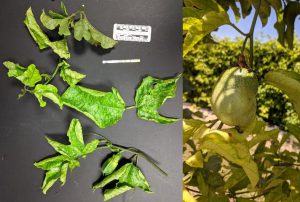Passion fruit woodiness virus (PWV) is the most important virus affecting passion fruit crops. PWV is transmitted by at least two aphid species. Disease can be spread from infected plants in nurseries to other plants. The Virus can infect passion fruit at any stages like the flowering stage, Fruiting stage, Seedling stage, and Vegetative growing stage. PWV and Cucumber mosaic virus (CMV) cause similar symptoms, but CMV does not cause woodiness symptoms on passion fruit.

Symptoms
- Leaves become distorted, rolled or folded, rugose.
- Chlorotic spots or ringspots on leaves
- The fruits become distorted with abnormal shape, and the edible part of the fruit becomes woody.
- Loss of vigor and reduced plant lifespan
- Whole plant shows dwarfing.
Prevention and Control
Newly infected plants may have no symptoms and are impossible to detect without laboratory techniques. Planting virus-free seedlings is the first step of prevention. Trimming tools between plants is also important to prevent virus transmission. Passion fruit plants should be periodically inspected for PWV symptoms. Consistent insecticide application to prevent aphid infestation is necessary to prevent woodiness disease. However, once a plant is infected, destroying the infected plant material is the only way to control the disease.
For more information, please read this article: https://www.cabi.org/isc/datasheet/39873
 0
0


